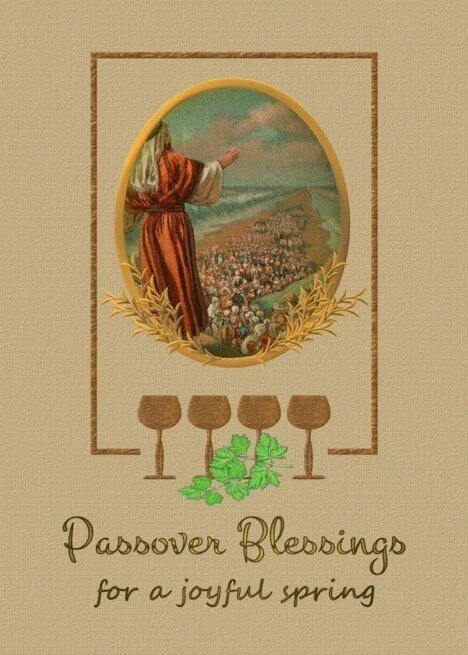Passover is a holiday beginning on the 14th of Nisan (first month of the religious calendar, corresponding to March–April) and traditionally continuing for eight days, commemorating the exodus of the Hebrews from Egypt. Every component of the observance, from the way the food is prepared to the order in which the food is consumed, has a historic and symbolic meaning. Services are held at the synagogues and lavish meals are served in elaborately decorated homes.
The name "Passover" comes from God's decision to spare the Jews when smiting down all the first borns in Egypt after Pharaoh refused to free the Jews from slavery.
Seder
One of the most important ritual actions of the Passover festival is the Seder which takes place on the first night of the seventh day.
The Seder is a traditional meal and prayer service commemorating the exodus of Jewish slaves out of Egypt. It follows the story of Moses, who according to the Old Testament, convinced the Pharaoh to free the Jews after unleashing ten plagues. In order of appearance, the ten plagues are as follows
1. Blood
2. Frogs
3. Lice
4. Wild Animals
5. Pestilence
6. Boils
7. Hail
8. Locusts
9. Darkness
10. First Born
The final plague was the killing of any first born son. Moses warned the Jews to mark their door with lamb's blood, the plague would just "pass over" and spare their children.
Hebrew Calendar
Because Judaism uses a lunar calendar, its festivals do not fall on regular days according to the Gregorian calendar used by most of the Western world. To compensate for "lost" days and to keep the calendar in tune with the seasons of nature, Judaism inserts a "leap month" or a second month of Adar every few years.
The first two days of Passover are no-work-allowed holiday days, followed by four days of Chol Hamoed, when work is allowed.
Chol Hamoed is followed by another two full holiday days.
Forbidden Foods
According to Judaic law, there are certain foods that are not to be eaten during Passover. Though there are variations, prohibited foods include the following:
-- leavened bread (bread with yeast or baking powder - anything that rises)
-- cakes, biscuits, crackers
-- cereal and coffees containing cereal derivatives
-- wheat, barley, oats, spelt, rye
-- corn, millet
-- legumes (beans and peas; however, string beans are permitted)
-- all liquids containing ingredients or flavors made from grain alcohol
Stores in Israel are prohibited by law from selling or even displaying Hametz (leavened bread) during Passover, according to the Matzot (Prohibition of Hametz) Law (5746-1986).
Recipe: Passover Matzo Pie (Mina Del Pesach)
from The Book of New Israeli Food
For the crust (for a 12-inch diameter round baking dish):
8-10 matzos
1/2 cup olive oil, for brushing
For the filling:
4 tablespoons oil
2-3 onions, chopped finely
3 cloves garlic
1 1/2 ground beef or lamb
Salt and coarsely ground black pepper
1/2 teaspoon cinnamon
4 eggs
2 to 3 tablespoons matzo meal
1 to 2 potatoes, cooked and mashed
1/2 cup pine nuts, roasted
1/2 cup fresh parsley, chopped (optional)
3/4 cup chicken stock
Dip matzos in a bowl of cold water for a few seconds, wrap in a towel and leave for 10-15 minutes until they soften and become flexible.
Prepare the filling: Fry the onions in the oil until they become golden. Add the garlic and the meat and continue frying until the meat is done.
Add the spices, remove from the stove, cool slightly and add the eggs, matzo meal, mashed potatoes, pine nuts and parsley. Mix well.
Preheat the oven to 350 degrees.
Assemble the pie. Grease the baking dish. Brush the wet matzos on both sides with a little oil and arrange on the bottom draping enough over the side to later cover the filling.
Spoon half the meat mixture into the baking dish and flatten. Cover with a layer of matzos and top with the remaining half of the meat. Fold the matzo draped over the side of the dish to cover the filling, brush with oil, place an additional matzo on top and brush that, too, with oil.
Bake for 25 to 30 minutes or until golden. Remove from the oven, spoon the soup over the pie and return to oven for another 5 minutes.
Cook slightly and serve.
Matzo
Many Jews eat matzo during Passover. A special unleavened bread, matzo is served to commemorate the hasty departure from Egypt when there was no time to bake regular leavened bread.
Havdalah
A Havdalah service marks the end of Passover, performed at nightfall the final night. This is a ritual ceremony that involves lighting a special havdalah candle with several wicks, blessing a cup of wine and smelling sweet spices.. Its purpose is to mark the division between the Passover holidays and the ordinary weekday.






